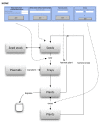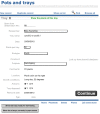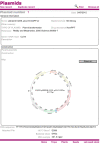Phytotracker, an information management system for easy recording and tracking of plants, seeds and plasmids
- PMID: 23062011
- PMCID: PMC3492177
- DOI: 10.1186/1746-4811-8-43
Phytotracker, an information management system for easy recording and tracking of plants, seeds and plasmids
Abstract
Background: A large number of different plant lines are produced and maintained in a typical plant research laboratory, both as seed stocks and in active growth. These collections need careful and consistent management to track and maintain them properly, and this is a particularly pressing issue in laboratories undertaking research involving genetic manipulation due to regulatory requirements. Researchers and PIs need to access these data and collections, and therefore an easy-to-use plant-oriented laboratory information management system that implements, maintains and displays the information in a simple and visual format would be of great help in both the daily work in the lab and in ensuring regulatory compliance.
Results: Here, we introduce 'Phytotracker', a laboratory management system designed specifically to organise and track plasmids, seeds and growing plants that can be used in mixed platform environments. Phytotracker is designed with simplicity of user operation and ease of installation and management as the major factor, whilst providing tracking tools that cover the full range of activities in molecular genetics labs. It utilises the cross-platform Filemaker relational database, which allows it to be run as a stand-alone or as a server-based networked solution available across all workstations in a lab that can be internet accessible if desired. It can also be readily modified or customised further. Phytotracker provides cataloguing and search functions for plasmids, seed batches, seed stocks and plants growing in pots or trays, and allows tracking of each plant from seed sowing, through harvest to the new seed batch and can print appropriate labels at each stage. The system enters seed information as it is transferred from the previous harvest data, and allows both selfing and hybridization (crossing) to be defined and tracked. Transgenic lines can be linked to their plasmid DNA source. This ease of use and flexibility helps users to reduce their time needed to organise their plants, seeds and plasmids and to maintain laboratory continuity involving multiple workers.
Conclusion: We have developed and used Phytotracker for over five years and have found it has been an intuitive, powerful and flexible research tool in organising our plasmid, seed and plant collections requiring minimal maintenance and training for users. It has been developed in an Arabidopsis molecular genetics environment, but can be readily adapted for almost any plant laboratory research.
Figures






Similar articles
-
SeedUSoon: A New Software Program to Improve Seed Stock Management and Plant Line Exchanges between Research Laboratories.Front Plant Sci. 2017 Jan 20;8:13. doi: 10.3389/fpls.2017.00013. eCollection 2017. Front Plant Sci. 2017. PMID: 28163712 Free PMC article.
-
QTREDS: a Ruby on Rails-based platform for omics laboratories.BMC Bioinformatics. 2014;15 Suppl 1(Suppl 1):S13. doi: 10.1186/1471-2105-15-S1-S13. Epub 2014 Jan 10. BMC Bioinformatics. 2014. PMID: 24564791 Free PMC article.
-
adLIMS: a customized open source software that allows bridging clinical and basic molecular research studies.BMC Bioinformatics. 2015;16 Suppl 9(Suppl 9):S5. doi: 10.1186/1471-2105-16-S9-S5. Epub 2015 Jun 1. BMC Bioinformatics. 2015. PMID: 26051409 Free PMC article.
-
Folic acid supplementation and malaria susceptibility and severity among people taking antifolate antimalarial drugs in endemic areas.Cochrane Database Syst Rev. 2022 Feb 1;2(2022):CD014217. doi: 10.1002/14651858.CD014217. Cochrane Database Syst Rev. 2022. PMID: 36321557 Free PMC article.
-
Why Seed Physiology Is Important for Genebanking.Plants (Basel). 2020 May 2;9(5):584. doi: 10.3390/plants9050584. Plants (Basel). 2020. PMID: 32370279 Free PMC article. Review.
Cited by
-
A software tool for the input and management of phenotypic data using personal digital assistants and other mobile devices.Plant Methods. 2015 Apr 7;11:25. doi: 10.1186/s13007-015-0069-3. eCollection 2015. Plant Methods. 2015. PMID: 25866550 Free PMC article.
-
Stakeholder-driven development and implementation of CRICIT: an app to support high-quality data capture and protocol monitoring for outpatient clinical trials with vulnerable populations.J Clin Transl Sci. 2023 Aug 14;7(1):e183. doi: 10.1017/cts.2023.609. eCollection 2023. J Clin Transl Sci. 2023. PMID: 37706003 Free PMC article.
-
SHiNeMaS: a web tool dedicated to seed lots history, phenotyping and cultural practices.Plant Methods. 2020 Jul 23;16:98. doi: 10.1186/s13007-020-00640-2. eCollection 2020. Plant Methods. 2020. PMID: 32714430 Free PMC article.
-
A variety test platform for the standardization and data quality improvement of crop variety tests.Front Plant Sci. 2023 Jan 24;14:1077196. doi: 10.3389/fpls.2023.1077196. eCollection 2023. Front Plant Sci. 2023. PMID: 36760650 Free PMC article.
-
SeedUSoon: A New Software Program to Improve Seed Stock Management and Plant Line Exchanges between Research Laboratories.Front Plant Sci. 2017 Jan 20;8:13. doi: 10.3389/fpls.2017.00013. eCollection 2017. Front Plant Sci. 2017. PMID: 28163712 Free PMC article.
References
-
- Jayashree B, Reddy PT, Leeladevi Y, Crouch JH, Mahalakshmi V, Buhariwalla HK, Eshwar KE, Mace E, Folksterma R, Senthilvel S, Varshney RK, Seetha K, Rajalakshmi R, Prasanth VP, Chandra S, Swarupa L, Srikalyani P, Hoisington DA. Laboratory Information Management Software for genotyping workflows: applications in high throughput crop genotyping. BMC Bioinformatics. 2006;7:383. doi: 10.1186/1471-2105-7-383. - DOI - PMC - PubMed
-
- Labcollector. http://labcollector.com/index.php/labcollector-add-onshtml.
Grants and funding
LinkOut - more resources
Full Text Sources
Miscellaneous

